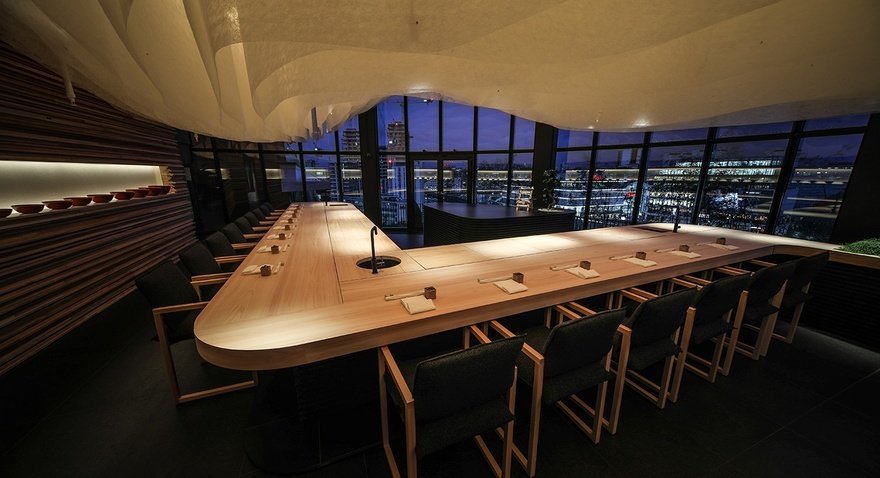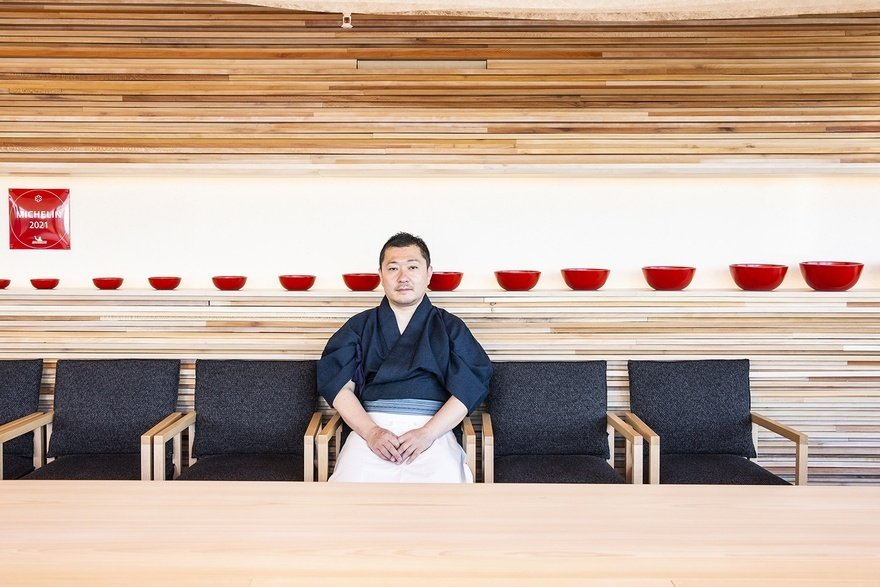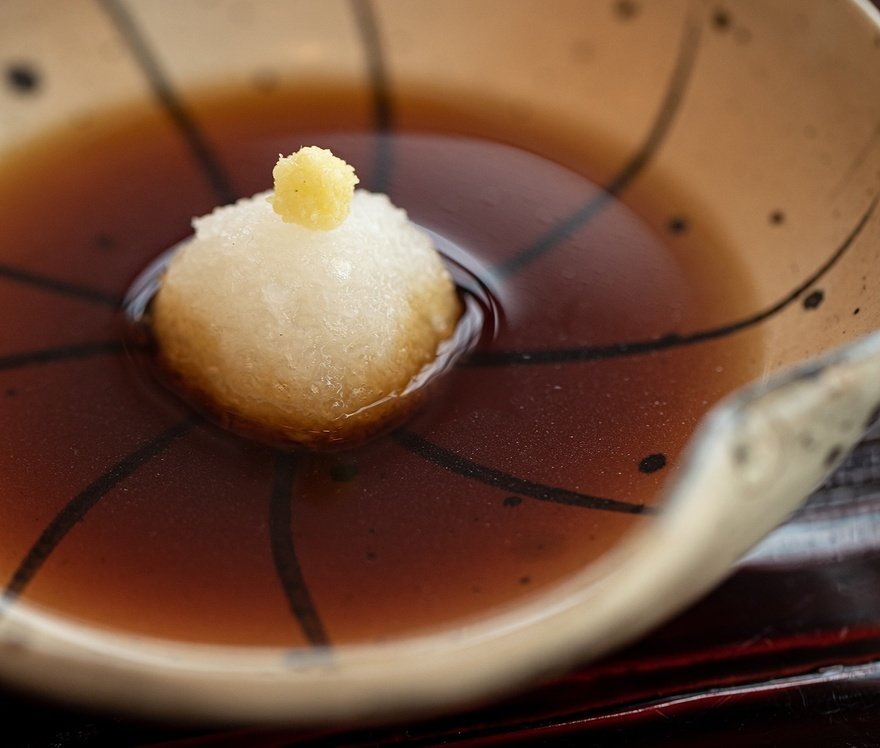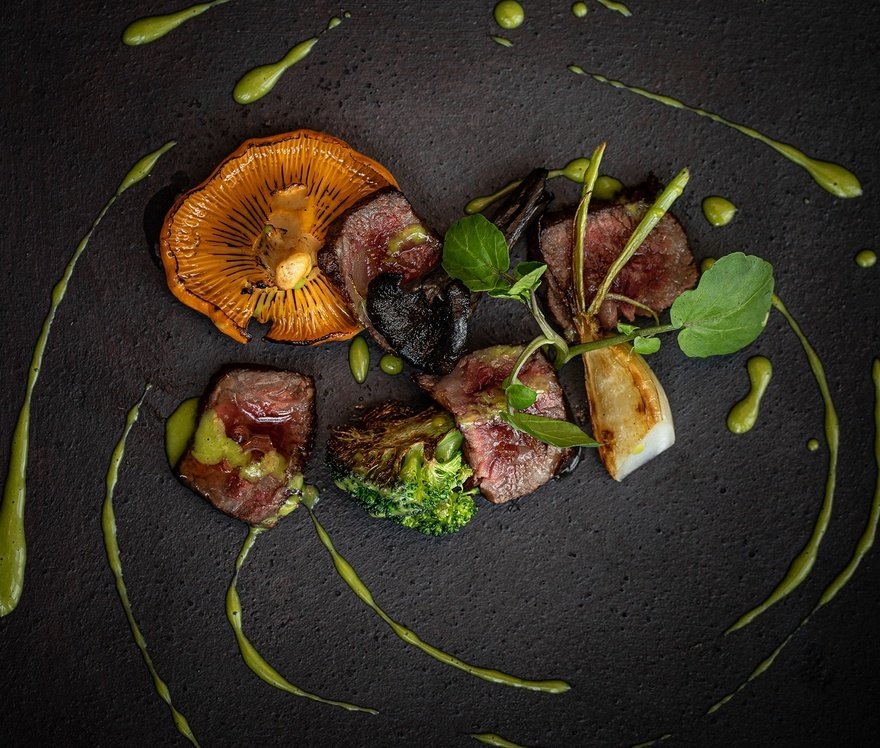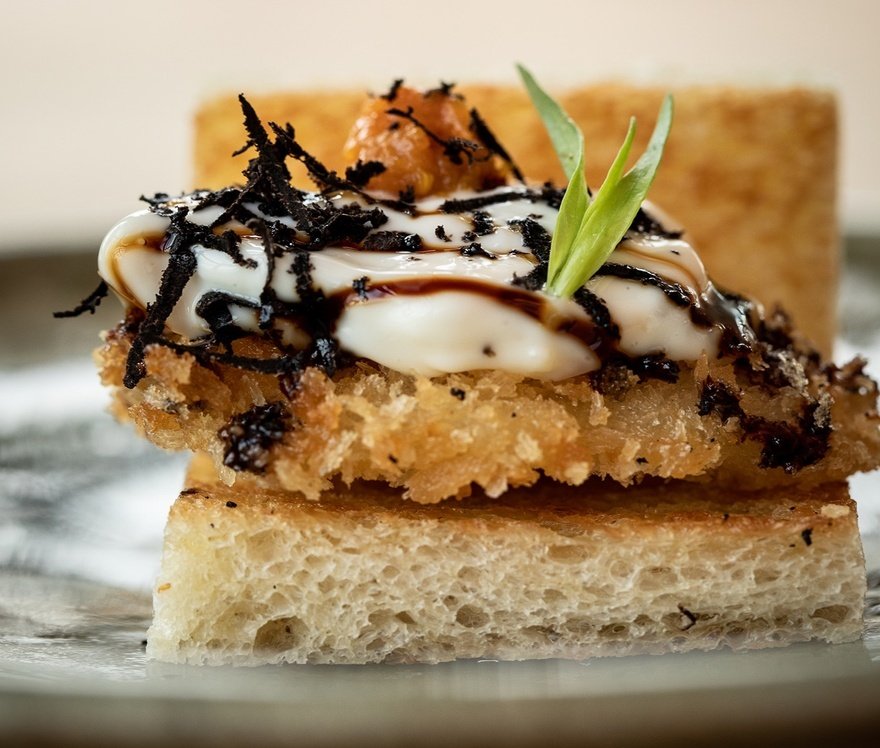Endo Kazutoshi's devotion to sushi is such that he imports mountain water from Japan to cook his rice. And with rave reviews and a Michelin star for his eponymous restaurant at West London's Rotunda, it seems his dedication is paying off. Tom Vaughan meets a chef setting the standard for high-end sushi.
Endo Kazutoshi stares down at the table. He's reflecting on the question: "When did you fall in love with sushi?" It's a pretty simple one. I'm hoping for a secret epiphany: a Road to Damascus moment with raw fish. He chews it over for a second longer then replies: "The answer is: I'm not so sure." Can he remember? Is it lost to time? Has it been swallowed up by hundreds of thousands of kitchen hours? No, he says. He can't answer, because it never happened. "I never think: do I like sushi or do I not like sushi?" he continues. "It is my life. Sushi is me. Sushi is my destiny."
I never think: do I like sushi or do I not like sushi? It is my life. Sushi is me. Sushi is my destiny
It's an answer that sums up Kazutoshi's utter single-mindedness – the same single-mindedness that saw him win a Michelin star within seven months of opening his first solo restaurant, Endo at the Rotunda in London's White City. The same single-mindedness that saw The Times' Giles Coren label his cooking as "probably the most perfect meal I have eaten in a restaurant in more than 20 years as a critic." The same single-mindedness that makes his 16-cover restaurant one of the most in-demand in London.
Almost overnight, a chef who had been quietly changing the capital's sushi tastes since 2006 – working behind the scenes at Zuma – was thrust into the limelight. And Kazutoshi is clear about one thing: his work here is far from done.
Breaking the mould
Kazutoshi has opened a second site, Sumi in Notting Hill (more of which later) but it was the opening of Endo at Rotunda, perched on the eighth floor of the old BBC building in White City, which truly announced him as a major player in the UK's restaurant scene. The chef is breaking the mould for high-end sushi – particularly with his choice of location. Most of his competitors are housed in cramped spaces in London's zone one, whereas Endo saw the potential in Rotunda, despite White City not exactly being renowned as a fine-dining destination.
"Everybody wants to open in Mayfair and Knightsbridge," says Kazutoshi. "I wanted to open in zone two or three. I believe in my team and that wherever we open we'll be great. If you have the confidence, it doesn't matter."
Having left Zuma in 2015 – after nine years as group head sushi chef – it took Kazutoshi almost three years to find the Rotunda site. But when he clapped eyes on it, he immediately knew it was perfect: "It reminds me of Tokyo."
He set about opening an omakase sushi restaurant (meaning: chef's choice) that made no compromises in its pursuit of perfection. Its airy, expansive interiors were designed by Kengo Kuma – architect of Tokyo's Olympic Stadium – complete with a 16-cover counter made from one-foot-thick Japanese hinoki cedar, regularly planed down to virgin wood. The rice was imported from Japan; the water the rice is cooked in – the same mountain water that it grows in – also imported from Japan to achieve the perfect pH. British, French and Portuguese day-boat fish suppliers were whittled down from a longlist of more than 300, and he adopted the seaweed recipe used by his grandfather, also a sushi master. Diners have to eat his langoustine nigiri within three seconds of presentation, lest it spoil. And so on.
All this is served in the spirit of ‘omotenashi', the Japanese art of hospitality (see panel). And when the reviews rolled in, it wasn't just Coren purring. Time Out called it "as close to a perfect omakase experience as you'll get", while Harden's ranked it the 18th best restaurant in the whole of the UK.
Going against the grain
The restaurant is a product of a mind that, as Kazutoshi happily admits, thinks about sushi 24 hours a day and is obsessed about every tiny detail. "I speak to our fishermen every day. About weather. About waves. Even if I'm hungover, I wake up and call the fishermen. Even if I'm in Paris, I call Devon. Every day I check the weather on my phone – Devon, Cornwall, Skye, France."
It is also the mind of someone who – as a third-generation sushi master – has blood that practically runs thick with raw fish. His father ran a restaurant in Yokohama; his grand- father one in Tokyo. Both were versed in the centuries-old techniques of edomae sushi. And yet Kazutoshi almost turned his back on the restaurant scene.
Growing up, his father didn't want "amateurs" in his kitchen, which left Kazutoshi spending a lot of time with his mother, whose approach to turning her son into a sushi master was to broaden his horizon outside of the kitchen. She enrolled him in classes for Ikebana flower arranging, chado tea making, Nihon-buyō dance and shodo calligraphy. However, it was at judo that he really excelled, winning a wrestling scholarship before completing a masters in sports science and sports management. On graduating, his old school asked him to come back and run their sports department, and that was nearly that.
"That was my dream come true. So I explained to my parents: unfortunately I can't take over the family sushi business," he explains. "My mum said: ‘Two choices. One, you take over the family business. Two, you follow your dream but you are not part of our family any more'."
Turning his back on his degree, Kazutoshi set about finding a sushi apprenticeship. "Sushi restaurant sons never work for their father. They always work at another place," he explains. He bought a guidebook, looked at the top 10 sushi restaurants in Tokyo and worked up from 10, "because I was too scared to work down from one".
The first five couldn't get past the fact that he was 22 – "they didn't want graduates, they wanted young people". The fifth – a five-seat omakase restaurant with a 5pm opening time and a 7pm closing time – asked him in for an interview. "[The sushi master] asked me where I lived and I said nearby. And he said: ‘If you work for me, you move into the apartment below the restaurant.' He wanted me to be thinking about sushi 24 hours."
And so began Kazutoshi's journey to becoming ‘as one' with sushi – 15-hour days, six days a week, living on-site and learning everything he could about the craft.
London calling
Nine years later, in 2005, he was working as a head chef in Tokyo when restaurateur Rainer Becker came knocking. Becker was on the hunt for a sushi chef for his three-year-old London restaurant Zuma, and was sent his way by a fellow stagière Kazutoshi had known at El Bulli.
"He flew to Tokyo. At the time I couldn't speak English at all," Kazutoshi explains. "Rainer came in and said he wanted to grow Zuma. He bought me an aeroplane ticket to London. He showed me everything – Zuma, Hakkasan, Nobu. He asked me: ‘What do you think?' I said: ‘Unfortunately, I'm disappointed.' I spoke straight. He said: ‘Yes, Endo, that's why we need you. You have to come over here and change London'."
So began Kazutoshi's partnership with Zuma – a collaboration that would last nine years and help transform the London sushi scene.
At first, Kazutoshi committed to two years in the UK, starting as Zuma's head sushi chef. The culture shock was severe. He remembers sitting in the weekly two-hour management meetings, unable to speak English. Then there was the state of the sushi scene – not just the standards, but the public's understanding of it. He remembers very early on a customer asking for some sashimi, wolfing it down and then asking how it was cooked. "I replied that it is raw. She complained to the general manager. She was so upset! ‘Why are you trying to kill me?'"
On arrival, he made one request to Becker: "Give me one year. I will change everything. You can change it back if you want. But he gave me freedom the whole time we worked together."
Over the course of nine years, he rose to the position of group head sushi chef, helping the 16-strong group open across the world and turning Zuma into the high watermark for sushi in London. He also learned to embrace his new home and its culinary potential. At first, he imported everything from Japan, but when the 2008 tsunami hit, exports dried up. He was forced to scour the UK for ingredients, calling 1,000 suppliers with his broken English. But he now raves about the quality of British seafood. "Mackerel here – amazing. That should be your national fish. Scallops from Orkney, I love. Brill from Brixham. That is also amazing!"
He also struck up a friendship with the River Café's Rose Gray. They met over the sushi counter at Zuma, she invited him in for a stage, and he returned to work at the River Café every Sunday – his day off – for a year. "She taught me so much about ingredients, about surviving in London. She said you have to stay in Zuma for 10 years, then you have to open a restaurant yourself, and you have to get a Michelin star."
He tells a heartbreaking story of their friendship at the very end – Kazutoshi sending Gray a bento box when she was hospitalised in the late stages of cancer. "Even though she couldn't eat, she tries my sushi and she rings me up – she sounds frail, like a little boy – to say how good it is." For a moment it looks like the emotion overcomes him. "I am happy I met her. Rainer Becker was my boss, but she was my mentor."
Putting down roots
Kazutoshi followed Gray's roadmap almost to the tee: nine years at Zuma, his own site in 2019, a Michelin star months later. And now he has a second restaurant to his name, Notting Hill's Sumi, which opened in lockdown. How does it differ from Rotunda? "Rotunda is small, always full, it has lots of rules – you must come at this time, please don't be late, please eat everything quickly. Sumi you can be a bit late, you can stay as long as you want. Sumi is more friendly, more neighbourhood. Endo is my father's name, a family name. Sumi is my mother's name."
He admits his family were "so upset" when he told them he was staying in London permanently, but his affinity for his adopted country runs deep. During lockdown – a year that he says nearly "broke his passion" – he produced 7,788 bento boxes that were donated to NHS staff and key workers.
Was he ever tempted to return to Tokyo after Zuma, rather than make London his permanent home? "If I had gone back to Japan and opened a restaurant it would be easier. I know the language, I know the fish. But I really want to educate, develop, help – and Tokyo doesn't need it. Tokyo doesn't need my ideas. But London is getting more famous for its sushi. It has so much potential."
I really want to educate, develop, help – and Tokyo doesn't need it. Tokyo doesn't need my ideas
The man who, for the past 15 years, has been setting the high benchmark for the capital's sushi isn't done yet. As a final question, I ask him where he'd like to see London's sushi scene in 10 years. This time, he doesn't bat an eyelid before answering: "I want it to be the best experience outside of Japan. Much more than Paris, much more than New York. I want London to be the best."
Endo Kazutoshi's restaurants
Endo at the Rotunda
Television Centre, 8th floor, the Helios, 101 Wood Lane, London W12 7FR
Opened April 2019
Covers 16, with two nightly sittings
Staff 10
Menu 15-dish tasting menu. Dishes include scallop with seven-month-aged caviar; eight-day-aged otoro nigiri; mackerel with Cornish potato; wagyu beef with Rokko miso
Average spend £330
Sumi
157 Westbourne Grove, London W11 2RS
Covers 40
Opened 2021
Staff 30
Menu À la carte sashimi, nigiri and temake sushi, plus main dishes including Japnese A4 wagyu 100g striploin with charred puntarella and a yuzu onion sauce
Average spend £62
The philosophy of omotenashi service
In 2013, ‘omotenashi' joined the cultural lexicon when it was referenced by TV personality Christel Takigawa in a speech to the International Olympic Committee, where she argued why Japan should host the 2020 Olympics. And yet it is a difficult concept to pin down in words.
At its simplest form, omotenashi refers to hospitality rather than service. But it also goes much deeper than that, says Kazutoshi. It is about detailed attention to the customer, pre-empting customer needs rather than responding to them. "I really want to take time with guests. I want them to come into a different world. It's a philosophy. A mentality."
Every detail at Endo at the Rotunda is rooted in omotenashi – from the serene surroundings to the spirit of openness and generosity. In turn, guests are expected to reciprocate by arriving on time for the twice-nightly sittings, eating each dish quickly for maximum flavour.
The restaurant's general manager Noemi Ribaric perhaps sums up the beating heart of omotenashi best: "We treat our team as family, so they care about each other. We are here because we want to be, not because it's our job or because it's paying our rent. It's a gratification to be able to make somebody else's day better because of us."
The origins of edomae sushi
Originating in Tokyo, when it was known as edo, edomae sushi is a style that can trace its roots back to the city's booming fast-food scene of the early 19th century. With regulations easing on who could open businesses, fast-food stalls shot up around the city's harbour areas to service busy labourers.
Sashimi had been a staple of Japanese cuisine for centuries, but edomae sushi was the first time it was paired with rice – a style now more commonly known as nigiri sushi.
With no refrigeration, the stalls found ways to prolong the shelf-life of the fish through the day – sea eel, shrimp and shellfish were simmered in broth; mackerel cured in vinegar; tuna, bonito and halibut were immersed in soy sauce; vinegar added to rice. With the invention of refrigeration, the style spread inland – but the curing and styles were maintained for their ability to bring out different, complex flavours in the raw fish. Fast-forward to today and two centuries of change has seen the style evolve and grow, while still staying true to the original methods of those 19th-century stall holders.
Portrait photography by Adrian Franklin / Hospitality Media
Continue reading
You need to be a premium member to view this. Subscribe from just 99p per week.
Already subscribed? Log In


